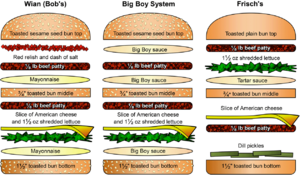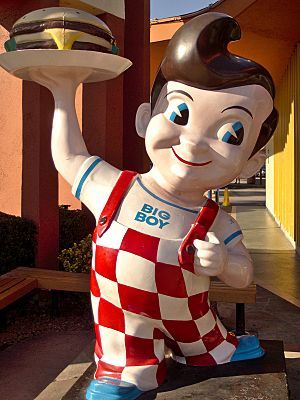Big Boy Restaurants facts for kids
Big Boy is a famous American restaurant chain. It's known for its tasty food and its fun mascot, a chubby boy with a cool hairstyle! The main company, Big Boy Restaurant Group, LLC, is based in Southfield, Michigan.
Big Boy restaurants have been around for a long time. The company that owns the Big Boy name has changed over the years. It started as Bob's Big Boy in 1936. Later, big companies like Marriott and Elias Brothers owned it. Since 2001, the Big Boy name has been managed by two main groups in the United States: Big Boy Restaurant Group and Frisch's Big Boy.
As of May 2025, there are 61 Big Boy restaurants run by Big Boy Restaurant Group in the United States. You can find them in Michigan, Nevada, North Dakota, Ohio, and California (where they are called "Bob's Big Boy"). There's even one Big Boy restaurant in Thailand! Frisch's Big Boy also runs 31 restaurants in the U.S. And in Japan, there's a separate company called Big Boy Japan that operates 274 restaurants.

Logo as of 2020
|
|
|
Trade name
|
Big Boy, Big Boy Restaurants |
|---|---|
| Private | |
| Industry | Casual dining restaurant Franchising |
| Predecessors | Big Boy Restaurants International, LLC Bob's Pantry Elias Brothers Restaurants, Inc. Marriott Corporation Robert C. Wian Enterprises |
| Founded | August 6, 1936 (as Bob's Pantry) Glendale, California, U.S. |
| Founder | Bob Wian |
| Headquarters | Southfield, Michigan, United States |
|
Number of locations
|
61 (2025) |
|
Area served
|
|
|
Key people
|
|
| Products |
|
Contents
Delicious Food at Big Boy
The Famous Big Boy Hamburger
The most famous item at Big Boy is its special double-deck hamburger. It has two thin beef patties, lettuce, a slice of American cheese, and a special sauce. Some Big Boy restaurants use mayonnaise and red relish, while others use a "special sauce" similar to thousand island dressing. Frisch's Big Boy uses tartar sauce and dill pickles.
This unique hamburger started as a fun idea in February 1937. A musician asked Bob Wian, the founder, for "something different." Bob quickly made a tall, stacked burger that looked "ridiculous." Everyone loved it, and soon it was called the "Big Boy" hamburger. In 1938, it cost only 15 cents! This burger was so popular that it inspired other famous double-deck hamburgers, like McDonald's Big Mac.
Other Popular Menu Items
Besides the Big Boy hamburger, the restaurants offer many other tasty foods. You can find breakfast items, different kinds of burgers and sandwiches, fresh salads, and full dinner plates.
Big Boy is also famous for its desserts! The Hot Fudge Cake and Strawberry Pie are very popular. Over the years, different Big Boy restaurants added their own special dishes, like the "Brawny Lad" hamburger and the "Slim Jim" sandwich.
The Big Boy Mascot
The Big Boy chain is easily recognized by its mascot. He's a cute, chubby boy with a cool pompadour hairstyle. He wears red-and-white checkered overalls and holds a Big Boy sandwich.
The real inspiration for the mascot was a six-year-old boy named Richard Woodruff. He walked into Bob Wian's diner, Bob's Pantry, just as Bob was trying to name his new hamburger. Bob said, "Hello, Big Boy," to Richard, and the name stuck! An artist from Warner Bros. Cartoons, Ben Washam, drew a cartoon of Richard, and that became the first Big Boy mascot.
Over the years, the Big Boy mascot's look changed a bit. In 1955, a designer named Manfred Bernhard updated the mascot's image. He made the fiberglass statues that you often see outside the restaurants.
Interestingly, one of the first Big Boy franchisees, Dave Frisch, created his own version of the mascot in 1951. This "East Coast Big Boy" was slimmer, wore striped overalls, and was often shown running. For a while, there were two different Big Boy mascots! But by the late 1960s, both characters were redrawn to look more similar, combining the best parts of both designs.
Big Boy Statues
Big Boy statues are a big part of the restaurant's image. Early statues were very tall, up to 16 feet! They usually showed the Big Boy mascot holding his hamburger. Later versions sometimes had him just holding his suspenders.
Sometimes, these statues have caused a bit of a stir! In some towns, there were rules about how big signs could be, and people debated if the Big Boy statue was a sign or a sculpture. In Norco, California, which is known as "Horsetown USA," the Big Boy statue even wears a cowboy hat and boots to fit in with the town's theme!
You can also find some unique Big Boy statues. In Cincinnati's Great American Ball Park, a Frisch's Big Boy statue wears a Cincinnati Reds baseball uniform. In some Michigan towns, you might see moose statues dressed in Big Boy overalls!
Many smaller versions of the Big Boy statues are sold as coin banks or bobblehead figures. You can also find inflatable Big Boy figures used for special events.
The Adventures of the Big Boy Comic Book
For many years, Big Boy restaurants gave out a free comic book called Adventures of the Big Boy to children. The comic book was meant to give kids something fun to do while they waited for their food. It featured Big Boy, his girlfriend Dolly, and his dog Nugget on exciting adventures.
Kids could also join the Big Boy Club through the comic books. Members would get free Big Boy hamburgers, decoder cards, and other cool prizes. These comic books were very popular, with millions of copies given away!
Famous comic book creators like Stan Lee (who helped create Spider-Man and other Marvel superheroes) and Bill Everett worked on the early Adventures of the Big Boy comics. Because there were two different Big Boy mascots (East Coast and West Coast), two versions of the comic book were made for a while, each featuring its own mascot.
The comic book series ran for 39 years and had 466 issues! In 1996, it was replaced by a magazine called Big Boy Magazine, which was published until 2008.
Big Boy's History
How Big Boy Started
Big Boy began in 1936 as Bob's Pantry in Glendale, California. It was started by a man named Bob Wian. He created the special double-decker hamburger that became so popular. Because the hamburger was such a hit, his restaurant soon became known as Bob's Big Boy.
At first, Bob Wian allowed other restaurant owners to sell his Big Boy hamburger. Then, in the 1950s, he created a formal franchising system. This meant other restaurants could open their own Big Boy locations, but they had to use their own name along with "Big Boy." That's why you had places like Frisch's Big Boy and Elias Brothers' Big Boy.
Changes in Ownership
In 1967, a large company called Marriott Corporation bought Big Boy. Later, in 1987, Elias Brothers, one of the biggest Big Boy franchisees, bought the chain from Marriott. Elias Brothers ran Big Boy until they faced financial trouble in 2000.
After that, an investor named Robert Liggett Jr. bought the company. He renamed it Big Boy Restaurants International. He also made an agreement with Frisch's Restaurants. This agreement meant that Frisch's became an independent owner of the Big Boy name in certain states, like Kentucky, Indiana, and parts of Ohio. So, Big Boy Restaurant Group and Frisch's are now separate companies that both own the Big Boy name.
Over the years, some Big Boy restaurants have closed or decided to operate independently without the Big Boy name. However, Big Boy Restaurant Group has also been opening new locations and expanding into new areas. For example, in 2020, they started opening restaurants in Nevada. In 2021, new Big Boy restaurants opened in Wisconsin.
In June 2023, Big Boy started opening new restaurants with a faster, simpler menu, bringing back the original "Bob's Big Boy" name for these locations.
In March 2025, Big Boy Restaurant Group began opening new restaurants called "Dolly's Burgers and Shakes" in some areas.
Big Boy Around the World
Big Boy has also tried to expand internationally. In the early 2000s, there were a few Big Boy restaurants in Thailand, but they eventually closed. However, in 2019, a company from Singapore signed a new agreement to open Big Boy restaurants in Thailand and other countries like Australia, China, and Japan. The first new Thai Big Boy restaurant opened in Bangkok in May 2020.
Images for kids
See also
 In Spanish: Big Boy (restaurante) para niños
In Spanish: Big Boy (restaurante) para niños
- List of hamburger restaurants
- List of casual dining restaurant chains
- List of franchises







